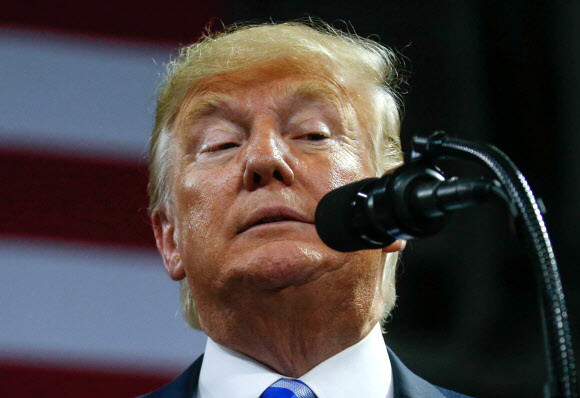hankyoreh
Links to other country sites 다른 나라 사이트 링크
Wall Street Journal says Trump wants S. Korea to double its burden of defense costs

With the defense cost-sharing agreement (known as the Special Measures Agreement) that South Korea and the US reached in Jan. 2014 expiring at the end of this year, An American newspaper is reporting that US President Donald Trump wants South Korea’s share of the defense burden to be as much as doubled from its current level.
“Trump wants South Korea to pay significantly more money for American troops stationed in South Korea,” the Wall Street Journal reported on Dec. 7, quoting sources who are familiar with the cost-sharing negotiations.
According to the Wall Street Journal, these sources said that Trump “wants South Korea to pay as much as double the current amount.”
“Others familiar with the talks said Mr. Trump’s administration is pushing for 150% of the current deal, or about US$1.2 billion,” the newspaper reported.
South Korea’s share of the cost of stationing around 28,500 American troops in its territory consists of the wages of South Koreans working for US Forces Korea, the cost of building military facilities and augmenting joint defense, and the cost of logistics support.
In 2018, the amount contributed by South Korea amounted to about 960.2 billion won (US$852.53 million). If the Wall Street Journal is correct, the US is asking the South Korean government to increase its yearly contribution to somewhere between 1.44 trillion won (US$1.38 billion) and 1.92 trillion won (US$1.7 billion).
South Korea and the US have held nine meetings aimed at renewing the Special Measures Agreement, or SMA, between March and October and are planning to hold a tenth meeting in Seoul from Dec. 11 to 13.
But the path to a final agreement is unlikely to be easy. Trump has openly pressured South Korea by taking issue with the cost of the American troop presence in South Korea. Importantly, American negotiators are asking that the cost of deploying strategic assets to the Korean Peninsula be established as the new category of “operational support,” which would constitute a major increase in the defense burden.
The South Korean government has countered by emphasizing the various contributions it has made, both direct and indirect, toward stabilizing the American presence on the Korean Peninsula.
One example cited by South Korean negotiators is Camp Humphreys, which was built with the South Korean government footing 92% of the total construction bill.
The Wall Street Journal also reported that some members of the Trump administration believe that the American troop presence in South Korea should not only be regarded in terms of its price tag.
“Other US diplomatic and military officials, including Defense Secretary Jim Mattis and Joint Chiefs of Staff Chairman Gen. Joe Dunford, have tried to convince Mr. Trump of the importance of the alliance, apart from the financial considerations,” the Wall Street Journal said, quoting sources.
“It is in the strategic interest of the US to have significant military forces stationed on the Korean Peninsula. It’s stabilizing for the region and helps us to defend our allies from a very real threat,” said Abraham Denmark, former Deputy Assistant Secretary of Defense for East Asia and current Director of the Asia Program at the Woodrow Wilson International Center for Scholars.
Earlier, South Korea’s Ministry of Foreign Affairs reported that South Korean Foreign Minister Kang Kyung-hwa and US Secretary of State Mike Pompeo met in Washington on Dec. 6 and agreed to continue encouraging their respective delegations to reach a mutually satisfactory outcome in the defense cost-sharing negotiations.
By Hwang Joon-bum, Washington correspondent
Please direct comments or questions to [english@hani.co.kr]

Editorial・opinion
![[Column] Has Korea, too, crossed the Rubicon on China? [Column] Has Korea, too, crossed the Rubicon on China?](https://flexible.img.hani.co.kr/flexible/normal/500/300/imgdb/original/2024/0419/9317135153409185.jpg) [Column] Has Korea, too, crossed the Rubicon on China?
[Column] Has Korea, too, crossed the Rubicon on China?![[Correspondent’s column] In Japan’s alliance with US, echoes of its past alliances with UK [Correspondent’s column] In Japan’s alliance with US, echoes of its past alliances with UK](https://flexible.img.hani.co.kr/flexible/normal/500/300/imgdb/original/2024/0419/2317135166563519.jpg) [Correspondent’s column] In Japan’s alliance with US, echoes of its past alliances with UK
[Correspondent’s column] In Japan’s alliance with US, echoes of its past alliances with UK- [Editorial] Does Yoon think the Korean public is wrong?
- [Editorial] As it bolsters its alliance with US, Japan must be accountable for past
- [Guest essay] Amending the Constitution is Yoon’s key to leaving office in public’s good graces
- [Editorial] 10 years on, lessons of Sewol tragedy must never be forgotten
- [Column] A death blow to Korea’s prosecutor politics
- [Correspondent’s column] The US and the end of Japanese pacifism
- [Guest essay] How Korea turned its trainee doctors into monsters
- [Guest essay] As someone who helped forge Seoul-Moscow ties, their status today troubles me
Most viewed articles
- 1[Column] The clock is ticking for Korea’s first lady
- 2Samsung barricades office as unionized workers strike for better conditions
- 3[Correspondent’s column] In Japan’s alliance with US, echoes of its past alliances with UK
- 4After 2 months of delayed, denied medical care, Koreans worry worst may be yet to come
- 5[Column] Has Korea, too, crossed the Rubicon on China?
- 6Hong Se-hwa, voice for tolerance whose memoir of exile touched a chord, dies at 76
- 7US overtakes China as Korea’s top export market, prompting trade sanction jitters
- 8All eyes on Xiaomi after it pulls off EV that Apple couldn’t
- 9[Photo] Smile ambassador, you’re on camera
- 10[News analysis] After elections, prosecutorial reform will likely make legislative agenda